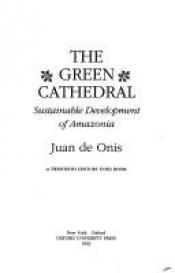The Green Cathedral: Sustainable Development of Amazonia
Blurb
When the first Iberian adventurers discovered the Amazon and the native Indian and tribal peoples living along its banks, they believed they had stumbled upon what one traveler later called "the unfinished last page of Genesis." Legends sprang up of El Dorado, the gilded man, and a golden city hidden along the river which would bring limitless wealth to its discoverer. Today the tropical rain forests of the Amazon have no less a hold on the world's imagination--environmentalists plead for the last great wilderness, a fragile Eden whose fate is intimately linked with the fate of the earth, while landless peasants and the garimpeiros, or wildcat miners, stream to what they perceive as the last frontier, rich in untapped resources and possibilities. The tension between the needs of the delicate and irreplaceable ecosystem and the no-less-compelling needs of the population seemed inevitable, and perhaps insolvable.In The Green Cathedral, Juan de Onis offers a set of proposals for the economic and ecological survival of this vital region, arguing that it is not possible to save the trees of Amazonia without also saving its people. A former foreign correspondent for the New York Times who has known Amazonia since the early sixties, de Onis undertook an intensive two year study of the region in 1988, travelling over 36,000 kilometers by land, water and air to interview the homesteaders, garimpeiros, cattle ranchers, bureaucrats, peasant organizers, Indians, and activists who together will decide the future of the vast forests. Avoiding the doomsday tone of many experts, de Onis not only draws a vivid portrait of the greenest part of the earth and the rawness of life on the frontier, but also argues that Amazonia is not yet ecologically ruined nor economically crippled. Indeed, he uncovers heartening evidence that the peoples and governments of Amazonia are learning from the past, finding ways of preserving and profiting from their environment. For instance, the farmers and ranchers notorious for slashing and burning the rain forest during the eighties' "decade of destruction" are finding that Amazonia's best yields are rubber, timber, cellulose, and genetic resources, the very renewable products that require careful cultivation and reforestation. This more balanced approach, argues de Onis, offers the most realistic hope for the region's teeming flora and fauna and for the world's burgeoning human population as well.
Published on the eve of the international environmental conference to be held in Brazil in June, 1992, The Green Cathedral will be welcomed as an inspiring, pragmatic call to action. It is essential reading for anyone interested in seeing the Amazon and its people steer from certain destruction towards a new era of discovery.

 English
English Español
Español Deutsch
Deutsch










Member Reviews Write your own review
Be the first person to review
Log in to comment